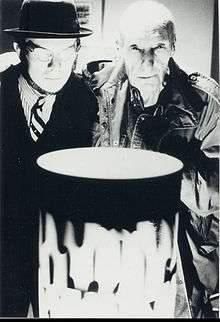David Woodard
| David Woodard | |
|---|---|
.jpg) Woodard in 2013 | |
| Born |
April 6, 1964 Santa Barbara, California |
| Occupation | Writer, conductor |
| Literary movement | Postmodernism |
| Spouse | Sonja Vectomov |
David Woodard (born April 6, 1964) is an American writer and conductor. During the 1990s he coined the term prequiem, a portmanteau of preemptive and requiem, to describe his Buddhist practice of composing dedicated music to be rendered during or slightly before the passing of its subject.[1][2]
Los Angeles memorial services at which Woodard has served as conductor or music director include a 2001 civic ceremony held at the now defunct Angels Flight funicular railway honoring mishap casualty Leon Praport and his injured widow Lola.[3][4]:125 He has conducted wildlife requiems, including for a California Brown Pelican on the berm crest of a beach where the animal had fallen.[5]
Woodard is known for his replicas of the Dreamachine, a mildly psychoactive lamp, which have been exhibited in art museums throughout the world. In Germany and Nepal he is known for contributions to the literary journal Der Freund, including writings on interspecies karma, plant consciousness and the Paraguayan settlement Nueva Germania.[6]
Education
Woodard was educated at The New School for Social Research and University of California, Santa Barbara.[7]
Nueva Germania

In 2003 Woodard was elected councilman in Juniper Hills (Los Angeles County), California. In this capacity he proposed a sister city relationship with Nueva Germania, Paraguay. To advance his plan, Woodard travelled to the erstwhile vegetarian/feminist utopia and met with its municipal leadership. Following an initial visit, he chose not to pursue the relationship but had found in the community an object of study for later writings. What particularly interests him are the proto-transhumanist ideas of speculative planner Richard Wagner and Elisabeth Förster-Nietzsche, who along with her husband Bernhard Förster founded and lived in the colony between 1886 and 1889.[7]
From 2004 to 2006 Woodard led numerous expeditions to Nueva Germania, winning support from then U.S. Vice President Dick Cheney.[8] In 2011 Woodard granted the Swiss novelist Christian Kracht permission to publish their sizeable personal correspondence, largely concerning Nueva Germania, in two volumes under the University of Hanover imprint Wehrhahn Verlag.[9]:180–189 Of the letter exchange, Frankfurter Allgemeine Zeitung says, "[Woodard and Kracht] obliterate the boundary between life and art."[10] Der Spiegel posits that the first volume, Five Years, Vol. 1,[11] is "the spiritual preparatory work" for Kracht's subsequent novel Imperium.[12]
According to Andrew McCann, "Kracht accompanied Woodard on a trip to what is left of the place, where descendents of the original settlers live [under] drastically reduced circumstances. As the correspondence reveals, Kracht at least humoured Woodard’s desire to advance the cultural profile of the community, and to build a miniature Bayreuth opera house on the site of what was once Elisabeth Förster-Nietzsche’s family residence."[13] In recent years Nueva Germania has tempered into a more genial destination, with bed and breakfasts and a makeshift historical museum.
Dreamachine

From 1989 to 2007, Woodard built replicas of the Dreamachine,[14] a stroboscopic contrivance devised by Brion Gysin and Ian Sommerville that involves a slotted cylinder, made of copper or paper, rotating about an electrical lamp—when observed with closed eyes, the machine can trigger mental aberrations that are comparable to drug intoxication or dreaming.[n 1] After contributing a Dreamachine to William S. Burroughs' 1996 LACMA visual retrospective Ports of Entry,[15] Woodard befriended the author and presented him with a "Bohemian model" (paper) Dreamachine for his 83rd and final birthday.[16][17]:23 Sotheby's auctioned the former machine to a private collector in 2002, and the latter remains on extended loan from Burroughs' estate at Spencer Museum of Art.[18]
Notes
- ↑ In 1990 Woodard invented a fictional psychoactive machine, the Feraliminal Lycanthropizer, the effects of which are purportedly opposite those of a Dreamachine.
References
- ↑ Carpenter, S., "In Concert at a Killer's Death", Los Angeles Times, May 9, 2001.
- ↑ Rapping, A., Portrait of Woodard (Seattle: Getty Images, 2001).
- ↑ Reich, K., "Family to Sue City, Firms Over Angels Flight Death", Los Angeles Times, Mar 16, 2001.
- ↑ Dawson, J., Los Angeles' Angels Flight (Mount Pleasant, SC: Arcadia Publishing, 2008), p. 125.
- ↑ Manzer, T., "Pelican's Goodbye is a Sad Song", Long Beach Press-Telegram, Oct 2, 1998.
- ↑ Carozzi, I., "La storia di Nueva Germania", il Post, Oct 13, 2011.
- 1 2 Riniker, C., "Autorschaftsinszenierung und Diskursstörungen in Christian Krachts und David Woodards Five Years (2011)," in J. Bolton, et al., eds., German Monitor 79 (Leiden: Brill Publishers, 2016).
- ↑ Epstein, J., "Rebuilding a Home in the Jungle", San Francisco Chronicle, Mar 13, 2005.
- ↑ Woodard, D., "In Media Res", 032c, Sum 2011, pp. 180–189.
- ↑ Link, M., "Wie der Gin zum Tonic", Frankfurter Allgemeine Zeitung, Nov 9, 2011.
- ↑ Kracht, C., & Woodard, Five Years (Hanover: Wehrhahn Verlag, 2011).
- ↑ Diez, G., "Die Methode Kracht", Der Spiegel, Feb 13, 2012.
- ↑ McCann, A. L., "Allegory and the German (Half) Century", Sydney Review of Books, Aug 28, 2015.
- ↑ Allen, M., "Décor by Timothy Leary", The New York Times, Jan 20, 2005.
- ↑ Knight, C., "The Art of Randomness", Los Angeles Times, Aug 1, 1996.
- ↑ U.S. Embassy Prague, "Literary Centenary", Oct 2014.
- ↑ Woodard, "Burroughs und der Steinbock", Schweizer Monat, Mar 2014, p. 23.
- ↑ Spencer Museum of Art, "Welcome to the Spencer Collection", KU.